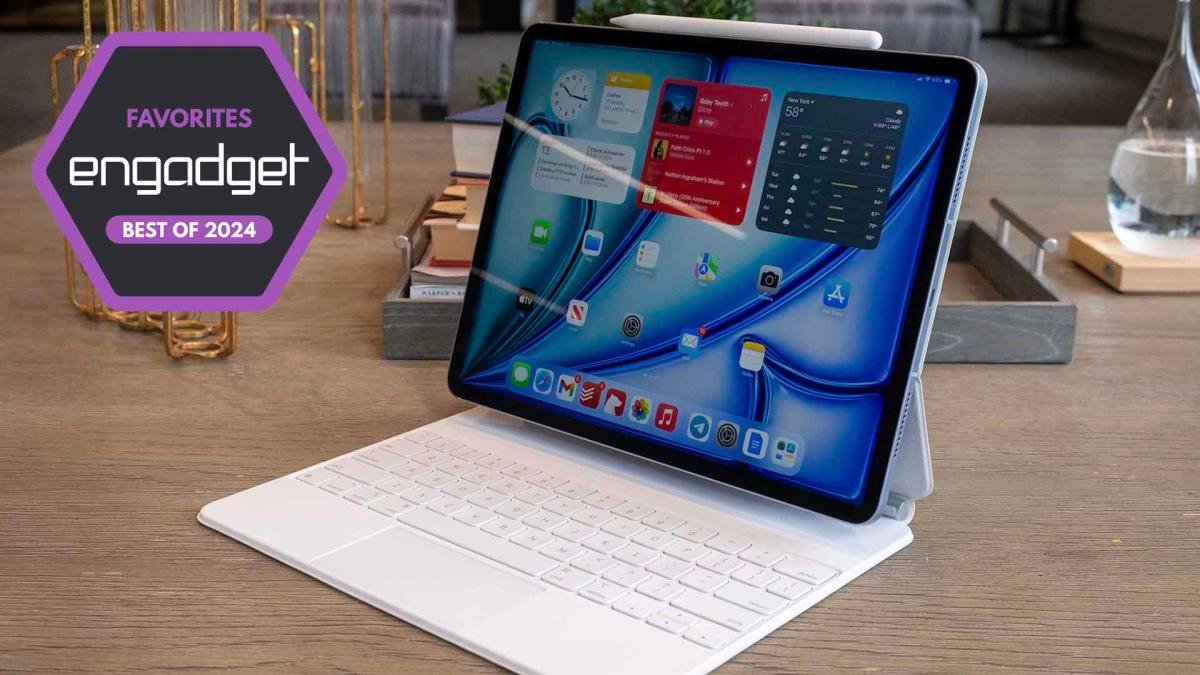Screen size: 11 inches or 13 inches | Display resolution: 2420 x 1668 (11-inch), 2752 x 2064 (13-inch) | Storage: Up to 2TB | RAM: Up to 16GB | Weight: 0.98 pounds (11-inch), 1.28 pounds (13-inch) | Battery life: Up to 10 hours | Front camera: 12MP | Back camera: 12MP
Read our full Apple iPad Pro (M4) review
The latest iPad Pro is more tablet than most people need, full stop. But if you have cash to burn, are determined to use an iPad as your main mobile computer or just want the most technically impressive iPad possible, this is it.
We gave the new iPad Pro a score of 84 in our review. Like the iPad Air, it comes in 11- and 13-inch models: The former starts at $999, while the latter starts at $1,299. That’s prohibitively expensive for most people, but for the money you get a number of premium, if inessential, upgrades over Apple’s other tablets.
The most significant of these is the Pro’s “tandem OLED” panel. Compared to the LCD screen on the iPad Air, this produces richer colors and deeper, more uniform black tones. Gaming and scrolling web pages look more fluid thanks to its faster 120Hz refresh rate. It can also get significantly brighter, reaching up to 1,000 nits in SDR and up to 1,600 nits with HDR highlights.
This is where the “tandem” part comes in. Essentially, Apple is stacking two OLED panels on top of one another to improve peak brightness, which is often a (relative) weakness of traditional OLED displays. It’s a breakthrough, but all you really need to know is that this screen is an absolute delight — one of the best we’ve seen on any consumer device, let alone a tablet. For watching movies or editing media, you really can’t do better. And unlike the previous-gen Pros, this display tech is used on both the 11- and 13-inch models, so which size is best merely comes down to personal preference.
The Pro’s design is broadly similar to that of the iPad Air, but these new slates are both slightly thinner and lighter than their Air counterparts. The difference isn’t huge on paper, but the Pro’s slimmed-down frames make them just that little bit easier to hold. It’s particularly meaningful with the 13-inch model. We’ll have to see if this has any effect on the tablets’ long-term durability, but both models feel sturdy at first blush.
The other headline upgrade is Apple’s new M4 SoC, which is only available with the new Pros at the moment. If the M2 is overkill for the vast majority of casual and pro-level iPad tasks, then the M4 is mega-kill; it easily chewed through just about anything we threw at it. But it should be even more futureproof, and it may save a few seconds here and there if your work involves high-res media editing, heavy use of machine learning and the like.
Beyond that, the base iPad Pro has 256GB of storage, which is twice as much as the iPad Air. It also supports more advanced features like hardware-accelerated ray tracing on its GPU, which could aid lighting in future games, and a faster neural engine, which may help with whatever AI features Apple has planned for iPadOS in the months and years ahead.
If you really want to max things out, note that the 1TB and 2TB configurations have twice as much RAM (16GB) and use a technically more powerful version of the M4 with an extra performance core unlocked. Jumping to one of those SKUs costs a minimum of $1,599, though — and that’s before you add any accessories. Those looking to use the iPad Pro as a (very expensive) media consumption device don’t need this; if you work with memory-hungry apps or need the absolute best, just note it’ll cost you.
The iPad Pro is the only iPad with Face ID, which remains more convenient than reaching for a fingerprint scanner. It sounds more robust than the Air, with four built-in speakers instead of two. It’s also the only one with a Thunderbolt USB-C port, which is technically faster for transferring large files. As for accessories, the Pro alone can use Apple’s latest Magic Keyboard, which is wildly expensive but has a more premium aluminum finish, a more spacious trackpad and a row of function keys. It also supports the Pencil Pro stylus (but not the second-gen Pencil). Like the Air, its front camera is located on the long edge.
If most of those features sound niche to you, well, yeah, that’s the idea. Unless you’re willing to pay for that terrific OLED display, the Air gets close enough for a much more palatable price. And though the iPad Pro is a class-leading tablet, it is ultimately still an iPad. Certain creative professionals can use it just fine as a laptop replacement, but for most, iPadOS still makes multitasking and other computer-y tasks more convoluted than they’d be on a MacBook. That said, it is a wonderful iPad — fast, slim and luxurious. And expensive.





